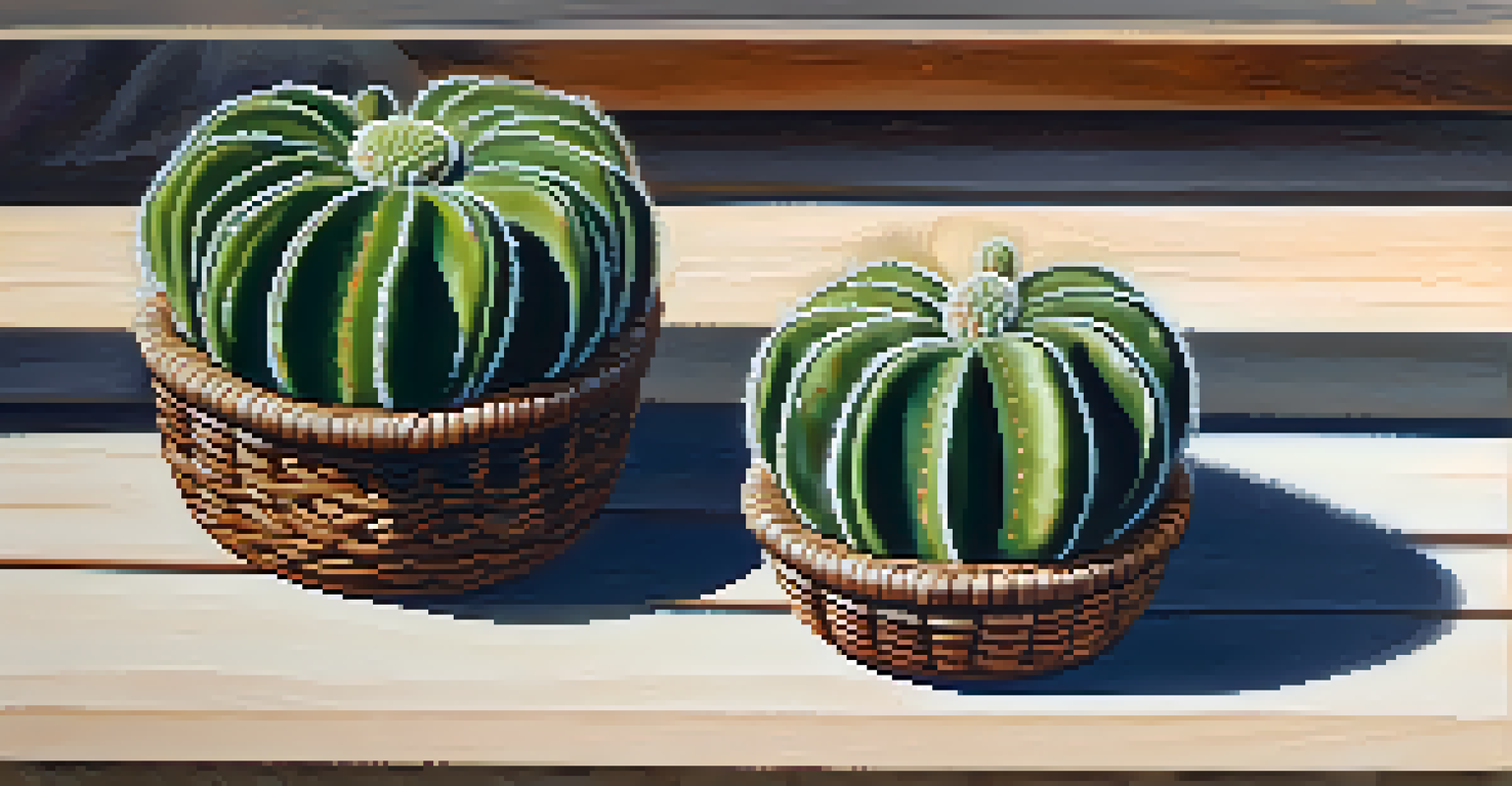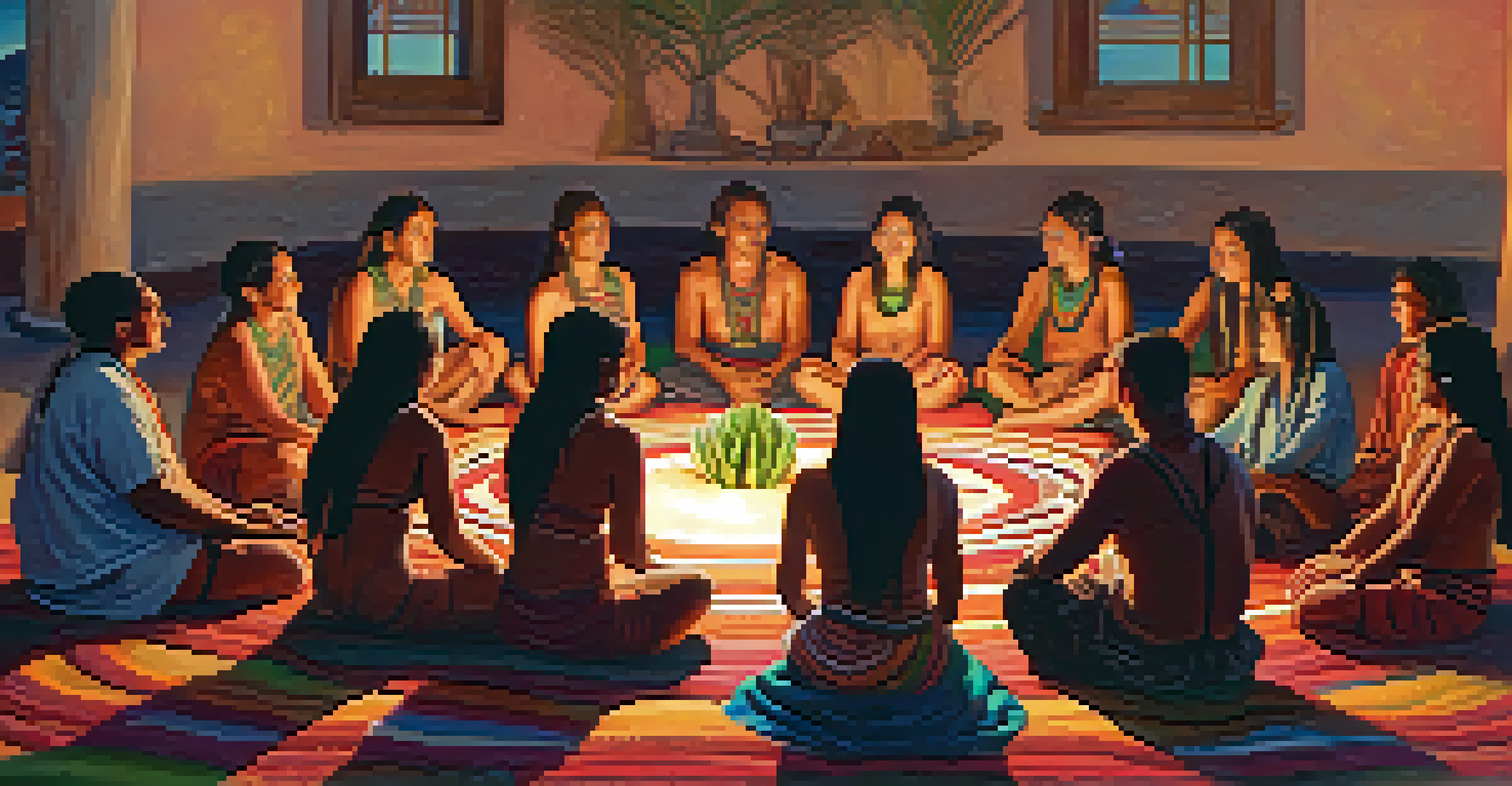The Role of Peyote in Indigenous Spiritual Practices Today

Understanding Peyote: A Sacred Cactus
Peyote is a small, spineless cactus known for its psychoactive properties, primarily due to the compound mescaline. For many Indigenous communities, particularly the Huichol and the Native American Church, peyote is more than just a plant; it's a sacred symbol of spirituality and connection to the divine. The cactus has been used for thousands of years in rituals and ceremonies, serving as a bridge between the physical and spiritual worlds.
The use of peyote in ceremonies is a profound expression of Indigenous identity and spirituality, allowing individuals to connect deeply with their roots and the natural world.
The significance of peyote lies in its ability to facilitate deep introspection and spiritual insight. When consumed during ceremonies, it is believed to open the mind and spirit, allowing individuals to experience visions and receive messages from ancestors or the Creator. This unique aspect of peyote has made it central to various Indigenous healing practices and cultural rituals.
Moreover, the reverence for peyote extends beyond its psychoactive effects; it represents a profound understanding of nature and the interconnectedness of all life. Through the lens of Indigenous spirituality, peyote serves as a reminder of the harmony that can exist between humans and the natural world, a lesson that continues to resonate today.
Peyote in Contemporary Indigenous Ceremonies
Today, peyote remains integral to many Indigenous spiritual ceremonies, especially within the Native American Church. These ceremonies often involve communal gathering, prayers, singing, and guided experiences that center around the use of peyote. Participants openly share their experiences, fostering a sense of community and collective healing.

The rituals surrounding peyote are not just about the consumption of the cactus; they are deeply rooted in tradition and cultural identity. Each ceremony is a reaffirmation of Indigenous identity and a way to pass down knowledge and values to younger generations. This continuity is vital for preserving the cultural heritage of Indigenous peoples in a rapidly changing world.
Peyote's Sacred Role in Culture
Peyote is a vital symbol for Indigenous spirituality, serving as a bridge to the divine and a means of cultural identity.
In addition to traditional uses, some Indigenous leaders are advocating for the recognition of peyote as a spiritual substance. This push for legal protection highlights the importance of preserving Indigenous rights and traditions in the face of modern legal challenges and societal changes.
The Legal Landscape of Peyote Use
The legal status of peyote varies significantly across different regions, often complicating its use in spiritual practices. In the United States, for example, peyote is classified as a Schedule I controlled substance, but there are exceptions for members of the Native American Church. This legal recognition underscores the importance of protecting Indigenous rights to practice their spirituality.
Peyote serves as a reminder of the harmony that can exist between humans and the natural world, a lesson that continues to resonate today.
However, the legal challenges do not end there. As interest in psychedelics grows in mainstream culture, concerns arise about cultural appropriation and the commercialization of peyote. Indigenous communities are often left defending their sacred practices against a backdrop of rising demand from non-Indigenous individuals seeking spiritual experiences.
Consequently, many Indigenous leaders are calling for more robust legal protections for peyote and its use. They emphasize the need for respectful engagement and understanding from outsiders, advocating for the preservation of their cultural heritage against exploitation.
Peyote as a Tool for Healing
In contemporary Indigenous spirituality, peyote is often viewed as a powerful tool for healing, both physically and spiritually. Many practitioners believe that the experiences facilitated by peyote can lead to personal transformation and recovery from trauma. This is especially significant in communities grappling with the historical impacts of colonization, such as loss of language, culture, and identity.
Through peyote ceremonies, individuals often confront their pain and seek clarity on their life paths. The collective nature of these ceremonies can also create a support network, helping participants heal together. This aspect of communal healing is a vital part of Indigenous culture, emphasizing the importance of community in individual well-being.
Legal Challenges and Cultural Rights
The legal status of peyote varies, highlighting the need for Indigenous rights protection amidst growing interest and potential exploitation.
Furthermore, as Indigenous communities face modern challenges, such as addiction and mental health issues, the traditional use of peyote is gaining recognition as a viable alternative to mainstream therapeutic practices. This resurgence of interest in Indigenous healing methods speaks to the broader movement of returning to traditional knowledge and practices for holistic wellness.
Cultural Significance and Identity
Peyote plays a crucial role in shaping Indigenous cultural identity, serving as a symbol of resilience and continuity. For many Indigenous peoples, participating in peyote ceremonies is not just a spiritual experience; it is an assertion of their cultural heritage and a way to connect with their ancestors. This connection helps to foster a sense of belonging and purpose in a world that often marginalizes Indigenous voices.
In recent years, there has been a resurgence of interest in Indigenous spirituality among younger generations. Many are turning to peyote ceremonies as a means of reconnecting with their roots and understanding their cultural identity. This revival is essential for sustaining the traditions and teachings that have been passed down through generations.
Moreover, the cultural significance of peyote extends beyond individual identity; it serves as a unifying force among different Indigenous communities. Through shared practices and beliefs surrounding peyote, diverse tribes can come together, fostering solidarity and mutual respect in their pursuit of cultural preservation.
Challenges Facing Peyote Use Today
Despite its deep-rooted significance, the use of peyote faces numerous challenges in today's world. Overharvesting and habitat loss have led to declining peyote populations, raising concerns about sustainability. As demand for peyote grows, especially from outside Indigenous communities, there is a pressing need for sustainable practices to protect this sacred plant.
Additionally, the commercialization of peyote poses a threat to its traditional use. As non-Indigenous individuals explore peyote for recreational or spiritual purposes, the risk of cultural appropriation increases. This can dilute the profound spiritual significance that peyote holds for Indigenous peoples, leading to tensions between traditional practitioners and those seeking to exploit its properties.
Peyote as a Healing Tool
Peyote ceremonies are seen as powerful avenues for healing and transformation, addressing trauma within Indigenous communities.
To address these challenges, many Indigenous leaders are advocating for conservation efforts and greater education about the cultural importance of peyote. By raising awareness, they hope to foster respect for the plant and its role in Indigenous spirituality, ensuring its preservation for future generations.
Looking Ahead: The Future of Peyote in Indigenous Spirituality
As we look to the future, the role of peyote in Indigenous spirituality will likely continue to evolve. With increasing interest in Indigenous practices and a growing understanding of the importance of traditional knowledge, there is potential for greater recognition and respect for the use of peyote. This could lead to more supportive legal frameworks and conservation efforts.
However, this future hinges on the balance between preservation and the risks of commercialization. Indigenous communities must be at the forefront of these conversations, ensuring that their voices are heard and their rights protected. It's essential to engage in respectful dialogue that honors the cultural significance of peyote rather than exploiting it for profit.

Ultimately, the future of peyote in Indigenous spirituality will depend on a collective commitment to understanding, respect, and sustainability. By working together, we can ensure that this sacred plant continues to be a source of healing, identity, and spiritual connection for generations to come.